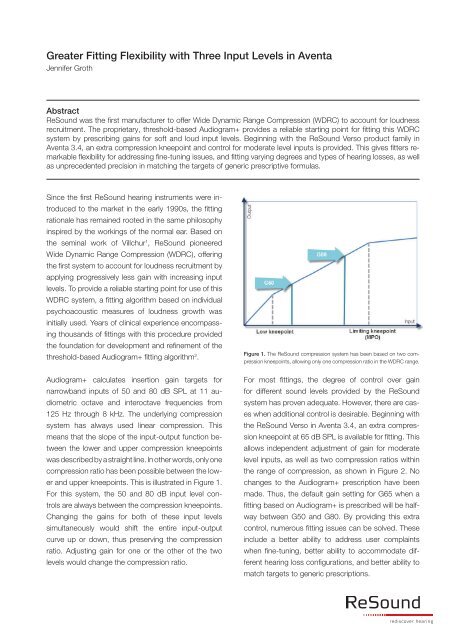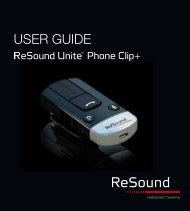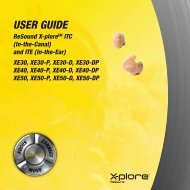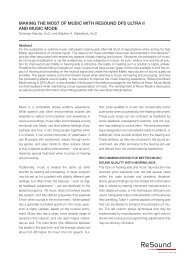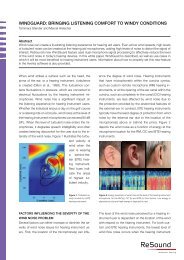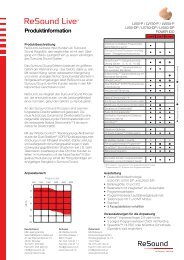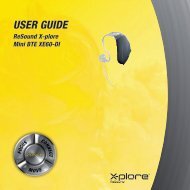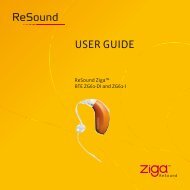Download now - GN ReSound
Download now - GN ReSound
Download now - GN ReSound
You also want an ePaper? Increase the reach of your titles
YUMPU automatically turns print PDFs into web optimized ePapers that Google loves.
Greater Fitting Flexibility with Three Input Levels in Aventa<br />
Jennifer Groth<br />
Abstract<br />
<strong>ReSound</strong> was the first manufacturer to offer Wide Dynamic Range Compression (WDRC) to account for loudness<br />
recruitment. The proprietary, threshold-based Audiogram+ provides a reliable starting point for fitting this WDRC<br />
system by prescribing gains for soft and loud input levels. Beginning with the <strong>ReSound</strong> Verso product family in<br />
Aventa 3.4, an extra compression kneepoint and control for moderate level inputs is provided. This gives fitters remarkable<br />
flexibility for addressing fine-tuning issues, and fitting varying degrees and types of hearing losses, as well<br />
as unprecedented precision in matching the targets of generic prescriptive formulas.<br />
Since the first <strong>ReSound</strong> hearing instruments were introduced<br />
to the market in the early 1990s, the fitting<br />
rationale has remained rooted in the same philosophy<br />
inspired by the workings of the normal ear. Based on<br />
the seminal work of Villchur1 , <strong>ReSound</strong> pioneered<br />
Wide Dynamic Range Compression (WDRC), offering<br />
the first system to account for loudness recruitment by<br />
applying progressively less gain with increasing input<br />
levels. To provide a reliable starting point for use of this<br />
WDRC system, a fitting algorithm based on individual<br />
psychoacoustic measures of loudness growth was<br />
initially used. Years of clinical experience encompassing<br />
thousands of fittings with this procedure provided<br />
the foundation for development and refinement of the<br />
threshold-based Audiogram+ fitting algorithm2 .<br />
Audiogram+ calculates insertion gain targets for<br />
narrowband inputs of 50 and 80 dB SPL at 11 audiometric<br />
octave and interoctave frequencies from<br />
125 Hz through 8 kHz. The underlying compression<br />
system has always used linear compression. This<br />
means that the slope of the input-output function between<br />
the lower and upper compression kneepoints<br />
was described by a straight line. In other words, only one<br />
compression ratio has been possible between the lower<br />
and upper kneepoints. This is illustrated in Figure 1.<br />
For this system, the 50 and 80 dB input level controls<br />
are always between the compression kneepoints.<br />
Changing the gains for both of these input levels<br />
simultaneously would shift the entire input-output<br />
curve up or down, thus preserving the compression<br />
ratio. Adjusting gain for one or the other of the two<br />
levels would change the compression ratio.<br />
Figure 1. The <strong>ReSound</strong> compression system has been based on two compression<br />
kneepoints, allowing only one compression ratio in the WDRC range.<br />
For most fittings, the degree of control over gain<br />
for different sound levels provided by the <strong>ReSound</strong><br />
system has proven adequate. However, there are cases<br />
when additional control is desirable. Beginning with<br />
the <strong>ReSound</strong> Verso in Aventa 3.4, an extra compression<br />
kneepoint at 65 dB SPL is available for fitting. This<br />
allows independent adjustment of gain for moderate<br />
level inputs, as well as two compression ratios within<br />
the range of compression, as shown in Figure 2. No<br />
changes to the Audiogram+ prescription have been<br />
made. Thus, the default gain setting for G65 when a<br />
fitting based on Audiogram+ is prescribed will be halfway<br />
between G50 and G80. By providing this extra<br />
control, numerous fitting issues can be solved. These<br />
include a better ability to address user complaints<br />
when fine-tuning, better ability to accommodate different<br />
hearing loss configurations, and better ability to<br />
match targets to generic prescriptions.
Figure 2. The updated <strong>ReSound</strong> compression system includes a gain control<br />
for moderate level sounds. This allows for two compression ratios within the<br />
WDRC range.<br />
UsInG G65 For FIne-TUnInG<br />
One way in which the G65 control enhances fitting<br />
flexibility is that it gives more options for addressing<br />
user complaints regarding loudness, feedback and<br />
speech audibility. By having control over soft, moderate<br />
and loud level sounds independently, it is easier<br />
to find a balance between these often opposing<br />
complaints. For example, Mr. V is fit with a Verso 62<br />
RIE open model. At the initial fitting, the G50 curve is<br />
at the maximum stable gain limit, and there is a slight<br />
tendency for the instruments to feed back. Therefore,<br />
the fitter reduced G50 and G65 in the high frequencies<br />
in order to reduce this tendency. When Mr. V returned<br />
for a follow up, he reported that feedback was not an<br />
issue, and that the sound levels were comfortable in<br />
all kinds of listening environments. However, he often<br />
felt the need to turn up the volume somewhat when<br />
conversing with individuals and at meetings. Based<br />
on Mr. V’s experience, the fitter increased the G65 by<br />
several steps from 1kHz and above to improve the<br />
volume and clarity for moderate level speech. Technically,<br />
this reduced the compression below 65 dB, and<br />
increased it slightly above. For Mr. V, this meant that<br />
the comfort for loud sounds was not affected, feedback<br />
tendency was not reintroduced, and moderate<br />
level speech was made more audible.<br />
Figure 3. Separate adjustments of gain for soft and moderate input levels<br />
helped to eliminate feedback, maintain comfort for loud sounds, and increase<br />
audibility for moderate level speech.<br />
Fitters who are accustomed to working with three input<br />
level controls will be able to apply their experience<br />
when working with the updated <strong>ReSound</strong> system. For<br />
those who are less familiar with this degree of control,<br />
the Aventa Guide provides suggestions for addressing<br />
common fitting complaints that incorporate the new<br />
65 dB input level control.
Figure 4. Aventa Guide incorporates the G65 control in providing suggestions<br />
to solve common fitting complaints.<br />
UsInG G65 For FITTInG dIFFerenT heArInG<br />
Loss conFIGUrATIons<br />
The <strong>ReSound</strong> WDRC fitting system was originally<br />
designed to compensate for mild-to-moderate sensorineural<br />
hearing losses. For more severe losses, this<br />
type of compression scheme presents a greater challenge<br />
to fit successfully. When fitting WDRC to individuals<br />
with severe-to-profound hearing losses, the<br />
compression characteristics will result in more gain<br />
for soft sounds and less gain for loud sounds relative<br />
to a linear scheme with the same gain for moderate<br />
level sounds. This can create problems with feedback<br />
as well as inadequate loudness. Nevertheless, those<br />
with more severe losses can potentially benefit greatly<br />
from compression if an appropriate balance in comfort<br />
and audibility can be achieved. Barker and colleagues3 found that fast-acting WDRC could be fit successfully<br />
to individuals with severe-to-profound hearing losses.<br />
However, many of the participants in their trial preferred<br />
higher compression kneepoints than typically<br />
characterize WDRC schemes. With the addition of the<br />
65 dB input level control in Aventa, the fitter can effectively<br />
decrease compression below the moderate<br />
input level if preferred by individuals with more severe<br />
losses. This is achieved by decreasing the G50. If the<br />
G50 is decreased to the level of G65, the compression<br />
kneepoint is in fact raised to this level. In doing this, the<br />
fitter can preserve audibility for moderate level speech,<br />
maintain comfort for loud sounds, and decrease feedback<br />
risk for those with severe-to-profound losses.<br />
Fitters may also find the 65 dB input level control useful<br />
when fitting individuals with conductive or mixed<br />
hearing losses. Although many fitting prescriptions,<br />
including Audiogram+, prescribe additional gain to<br />
overcome some of the attenuation resulting from the<br />
conductive impairment, there is no consensus on<br />
how that should be done. In such cases, the added<br />
flexibility of the moderate level control may be invaluable.<br />
For example, a user with a conductive loss might<br />
report that loudness and clarity are generally fine, but<br />
that loud sounds are uncomfortable or tend to be<br />
distorted. In this case it might be helpful to decrease<br />
G80. This should help with comfort without degrading<br />
what the user likes about the fitting.<br />
UsInG G65 For more AccUrATe FITTInG To<br />
GenerIc prescrIpTIons<br />
Many professionals follow fitting protocols that require<br />
fitting and verification according to scientifically validated,<br />
peer-reviewed prescriptions. Aventa facilitates this<br />
process by offering automatic adjustment to a number<br />
of such prescriptions, including NAL-NL1, NAL-NL2,<br />
DSL i/o and DSL 5. While Audiogram+ prescribes<br />
linear compression between the lower and upper<br />
compression kneepoints, generic prescriptions may<br />
differ. In the example in Figure 5, the same mild-tomoderate<br />
sloping audiogram was used to prescribe<br />
fittings based on NAL-NL2, DSL i/o and Audiogram+.<br />
The same signal type is assumed in each case. As<br />
can be seen, these three formulas each prescribe the<br />
compression in a different way. While NAL-NL2 prescribes<br />
a more linear response as input level increases,<br />
DSL i/o does the opposite. Without the separate<br />
control for G65, the hearing instrument would not be<br />
able to meet each of these prescriptive targets.
Figure 5. Fitting rules often differ in how compression is prescribed for a particular<br />
audiogram. With the added flexibility of a separate control for moderate<br />
inputs, targets can be more accurately met for a variety of different formulas.<br />
sUmmAry<br />
Fine-tuning to patient preferences, accounting for<br />
different types of hearing losses, and accurate fitting<br />
to generic fitting formulas are benefits of the flexibility<br />
afforded by control over gain for soft, moderate and<br />
loud sound levels. Beginning with Resound Verso,<br />
fitting professionals have access to this important<br />
fitting feature.<br />
Worldwide headquarters<br />
<strong>ReSound</strong> A/S<br />
Lautrupbjerg 7<br />
DK-2750 Ballerup<br />
Denmark<br />
Tel.: +45 45 75 11 11<br />
Fax: +45 45 75 11 19<br />
www.resound.com<br />
reFerences<br />
1. Villchur E. Signal processing to improve speech<br />
intelligibility in perceptive deafness. Journal of the<br />
Acoustical Society of America. 1973; 53: 1646-1657.<br />
2. Audiogram+: The Resound Proprietary Fitting Algorithm.<br />
<strong>ReSound</strong> white paper. 2009.<br />
3. Barker C, Dillon H, Newall P. Fitting low ratio compression<br />
to people with severe and profound hearing<br />
losses. Ear and Hearing. 2001; 22(2): 130-141.<br />
M200770-GB-12.05-Rev.A


